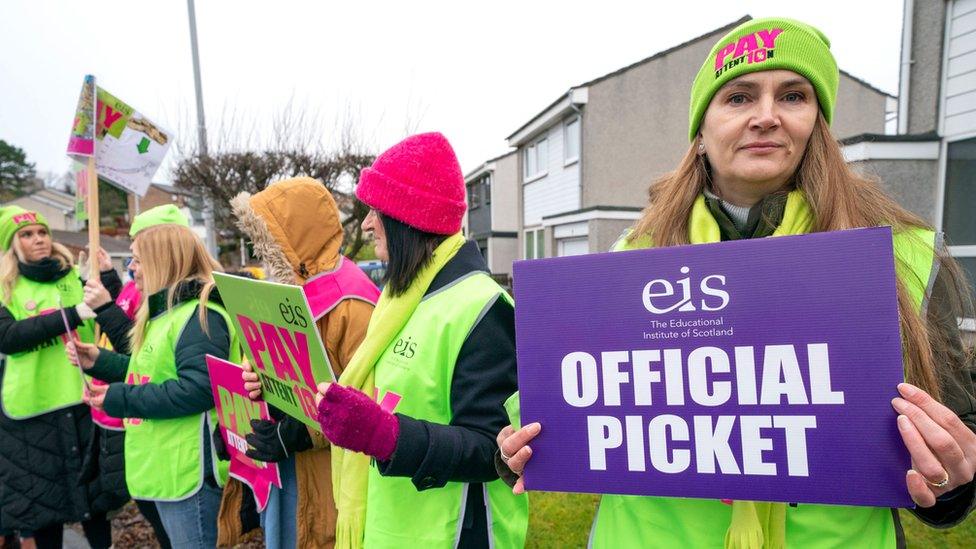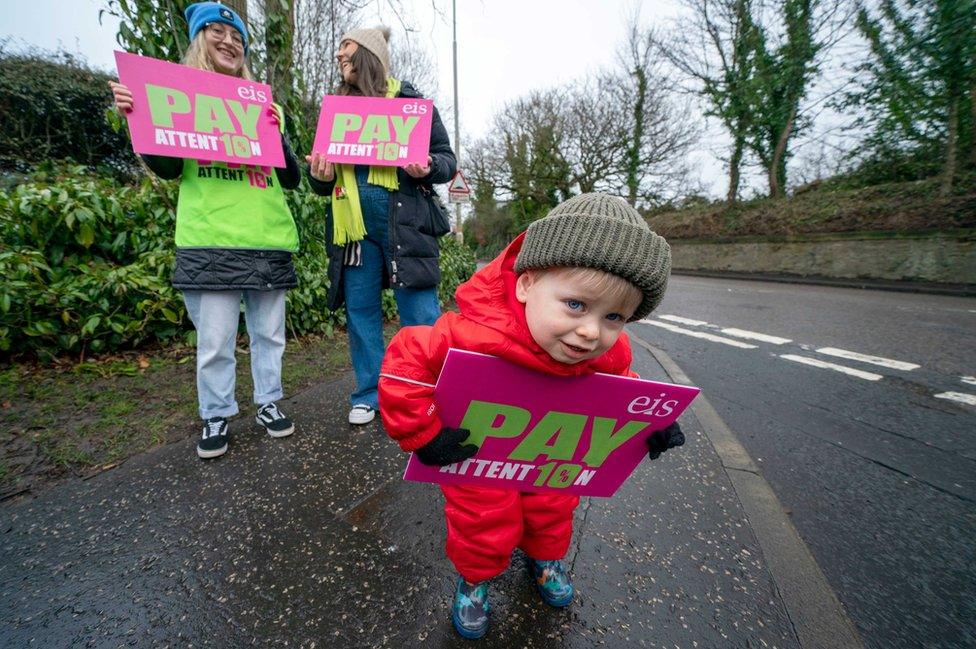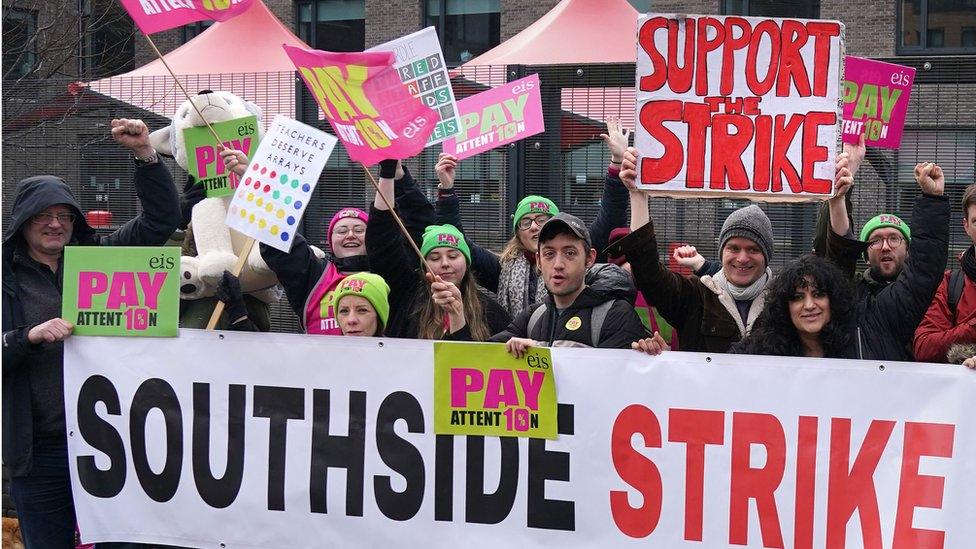Teachers' union defends three days of targeted strikes
- Published
- comments

Strike action has targeted the constituency of Education Secertary Shirley-Anne Somerville
Scotland's largest teachers' union has defended its decision to stage three days of targeted strike action.
The Educational Institute for Scotland (EIS) members have taken action at schools in the constituencies of politicians close to the pay dispute.
These include areas represented by First Minister Nicola Sturgeon and her deputy John Swinney.
Mr Swinney, whose own son is affected by the strike action, said it was "inequitable and indefensible".
But EIS general secretary Andrea Bradley said the union, which rejected a new pay offer last week, had been "left with no other option but to escalate action to intensify the pressure on key decision-makers".
On Wednesday afternoon members of the NASUWT teaching union also confirmed they had turned the revised pay offer.
Earlier Ms Bradley told the BBC's Good Morning Scotland programme that the targeted action was designed to "bring a swifter resolution to the dispute".
Ms Bradley said the action was "very much focused on the politicians"and there was "no intent to target more or less affluent areas".
She added: "It is very clear the targets for this swathe of action are decision-makers who continue to withhold the very modest resource that would bring forth a settlement to this dispute."

Dr Patrick Roach, NASUWT general secretary, said while the latest pay proposals were a "marginal improvement" they still amounted to a real terms pay cut.
He added: "The fact that the majority of our members have told us they reject this offer reflects the depth of anger amongst teachers who have endured cuts to their pay, despite rising levels of workload and deterioration in their working conditions.
"Our members expect a real pay rise which reflects the hugely important and challenging nature of teaching."
'Inequitable and indefensible'
Mr Swinney said he was "very sorry" for the families and young people affected by the latest strike action.
"I think it is completely inequitable and indefensible," he said.
"I talk to lots of teachers and many of them can't understand why that offer has not been put to them."
He said that if they accepted the deal, there would be an 11.5% increase in their pay packets by the end of April.
"I think that requires reconsideration because teachers need to be given the chance to vote on that," Mr Swinney added.
"The government and local authorities have moved. We have put more money on the table and tried to resolve the issue.
"The fact it hasn't been put to members means it is difficult to hear any justification [for the action]."


The latest teachers' strikes mark a significant change in tactics.
Targeting schools in five areas echoes the long-running teachers' dispute of the mid 1980s, when there was additional action in the constituencies of some Conservative government ministers.
But there is a significant practical difference this time.
In the 1980s, the targeted schools were often, though not always, in relatively prosperous areas with few children who could be considered disadvantaged.
But some of the schools affected this time serve areas which are not affluent.
It should be stressed that it is not the intention of the union to target individual children or families - it is about putting pressure on politicians.
But inevitably the new tactic is something of a gamble.
Is there a risk that targeting could prove counterproductive and alienate some parents? Or will it add to the pressure on senior politicians to improve the pay offer and lead to a resolution?

The latest offer included a 6% pay rise for the current year - backdated to April 2022 for teachers who earn up to £80,000 - and a further 5.5% in the new financial year.
The EIS is seeking a 10% pay increase, which ministers say is unaffordable.
While the EIS and NASUWT have now turned down the offer the SSTA union said they would consider it.
The schools targeted in the latest action face 10 days of strikes over the next two months if the dispute is not settled.
Two days of national strike action are planned on 28 February and 1 March.
This will be followed by a further 20 days of regional rolling strikes across Scotland between 13 March and 21 April, with each school being hit twice.

Schools in Nicola Sturgeon's constituency were also targeted
The targeted strikes are taking place between Wednesday and Friday this week in the constituencies of Nicola Sturgeon (Glasgow Southside), John Swinney (Perthshire North), Education Secretary Shirley-Anne Somerville (Dunfermline) and the East Dunbartonshire Council area of Scottish Greens education spokesperson Ross Greer's West Scotland region.
A further three days of action from 7 March will target these constituencies and the ward of Dumfries and Galloway councillor Katie Hagmann, the resources spokesperson for council umbrella body Cosla.
Ms Somerville said she was focused on resolving the dispute and has written an open letter to pupils outlining the support available during industrial action.
She said the threat of further disruption in the run-up to exams was "particularly concerning".
She has written to local authorities asking them to consider how secondary schools can remain open for pupils preparing for exams, which is "being reviewed by councils on a school by school basis."
Leanne McGuire, chair of the Glasgow City Parents Group, said they could not support the latest targeted action as it was "unfair" to pupils and families in those areas.
"The area of Nicola Sturgeon's constituency (Glasgow Southside) contains certain high-deprivation areas," she told Good Morning Scotland.
"Those pupils are already at a disadvantage when it comes to education, and we just feel these additional six days put them at further disadvantage, compared to peers on the opposite side of the city."